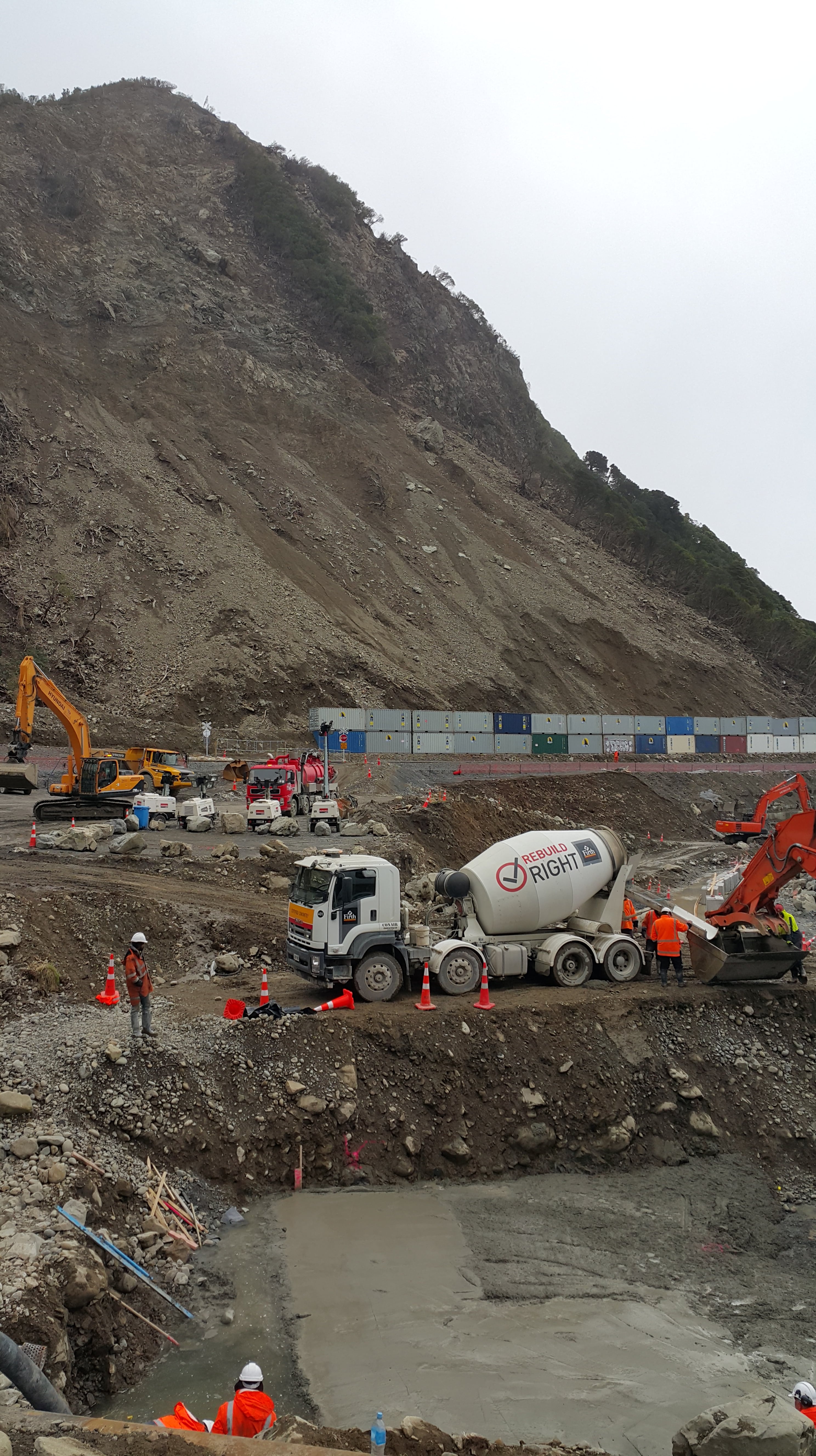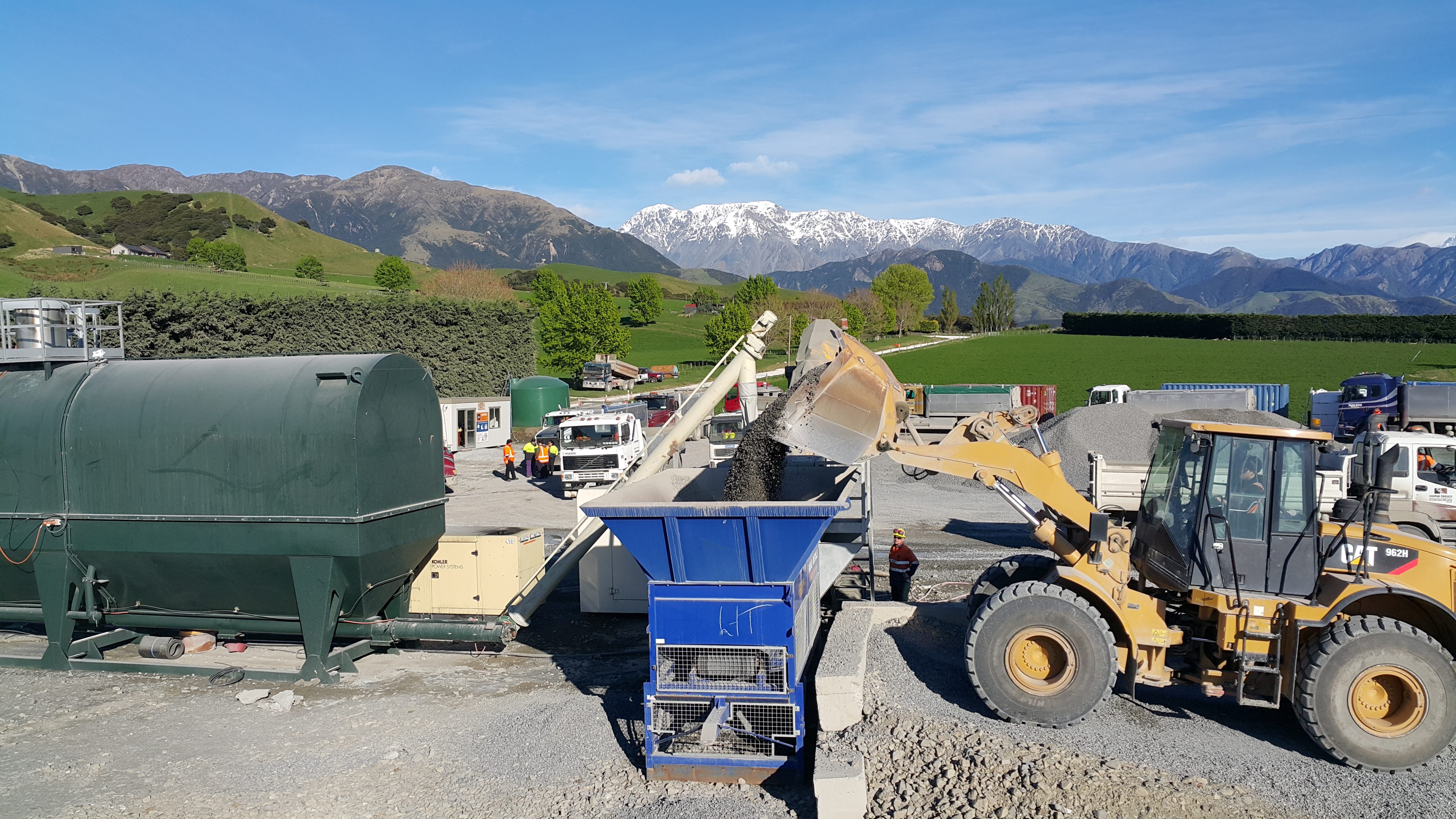
Once daylight broke on the devastation wrought by the 2016, 7.8 magnitude Kaikoura earthquake and authorities could survey the damage, there was no doubt that to repair the State Highway along the coast was going to take huge amounts of labour, funds and – now it appears – a record amount of concrete.
In May, in support of the disaster response, Firth relocated a mobile batching plant to a site at Clarence River and began producing concrete to support NCTIR (North Canterbury Transport Infrastructure Recovery Alliance) with the aim of opening the road by Christmas.
“This project has been full of twists from the outset which isn’t unexpected on a project of this scale,” says Ryan Jones, Procurement Manager for NCTIR. “The Government set the target of opening by Christmas, so the people and businesses of Kaikoura can get back to normal as soon as possible. It has been extremely complex but we needed to make sure that SH1 and the rail network are reliable and safe when opened. I have been amazed at how our teams, and suppliers like Firth, have jumped on board to work towards what was a tough target.”
“We know Firth very well and have a great relationship with Dom Sutton and his team. To their credit they understood the challenge and took what we were trying to do seriously and responded accordingly.”
“I think once everyone got underway on site it became evident that it truly was a mammoth task and that initial projections on what was required, in the way of concrete volumes to get the road opened by Christmas, were not going to be enough,” explains Dominic Sutton, Head of Certified (Southern) for Firth. Once more accurate volume requirements were announced for concrete supply north of the slip, Dom says he knew it would take considerable resource and careful management from his South Island teams to ensure supply in the time frames requested by NCTIR.
“The updated figures we were given were 8,000m3 of standard concrete and 40-50,000m3 of ‘no fines’ concrete,” says Dom. “The no fines concrete is a low strength mix used for back filling retaining walls, in this case the sea wall, and to use beneath the road for stabilisation.”
Firth relocated a further plant on site to be able to produce the more than 50,000m3 of concrete required in just a few short months. “It helps that the aggregate for the no fines concrete is being supplied by NCTIR from the Clarence River (Kaikoura) and the aggregate for the standard concrete is coming from our Blenheim plant’s supplier. The second plant is what is called a ‘pug mill’ plant, which mixes the concrete that is then loaded into tipper trucks.”
Manning this fast paced operation is challenging with employees being put up on site by NCTIR or driving down from Blenheim. Often equipment and people are being flown in by helicopter to keep up with the schedule. “Both plants are operating 10 hours a day and six days a week,” adds Dom. “I think by mid October we will have supplied 5,000m3 standard concrete and 20,000m3 of no fines. It’s a big ask but we’re getting there.”
“I know a lot of people have looked at this challenge and thought ‘wow that's a big ask’ but to everyone’s credit - and with a tremendous amount of effort and dedication by all - it’s looking like we’ll get there,” adds Ryan.
The work:
Large slips North and South of Kaikoura had to be stabilised before work to clear the landslides could begin safely. For five months helicopters with monsoon buckets laden with sea water sluiced hillsides to loosen rubble and induce rockfall before a team abseiled in to dislodge and blast away larger rocks.
Slip stabilisation included:
- Installation of rock fall fencing - used in lower energy areas.
- Installation of high tensile steel mesh to rock faces.
- Creation of rock fall protection structures using pre-cast concrete and earth bunds.
Once it was safe to have people underneath, teams began removing slip material and creating sea walls to bring the road and rail out from some of the larger slips.
The numbers:
- 1500 damaged sites - 200 sites with major damage, 100 damaged structures – 9 suffered significant damage, 50 damaged retaining walls between Cheviot and Clarence
- More than 40 damaged sites have been repaired on the Inland Road (Route 70)
- 9 major slips north of Kaikoura, more than 30 slips south of Kaikoura
- 69 road bridges affected - two requiring total replacement
- There is a 300-bed purpose-built, prefabricated temporary workers accommodation village in Kaikoura for those working on the massive rebuiid
- In the first six months there were more than 1000 people from more than 100 organisations involved. This grew to 2000 people at one stage
Principal: NZ Transport Agency
Customer: North Canterbury Transport Infrastructure Recovery (NCTIR)
Contractor: Fulton Hogan
Location: SH1, Kaikoura
Product: Certified Concrete®
Video of work site: Click here

